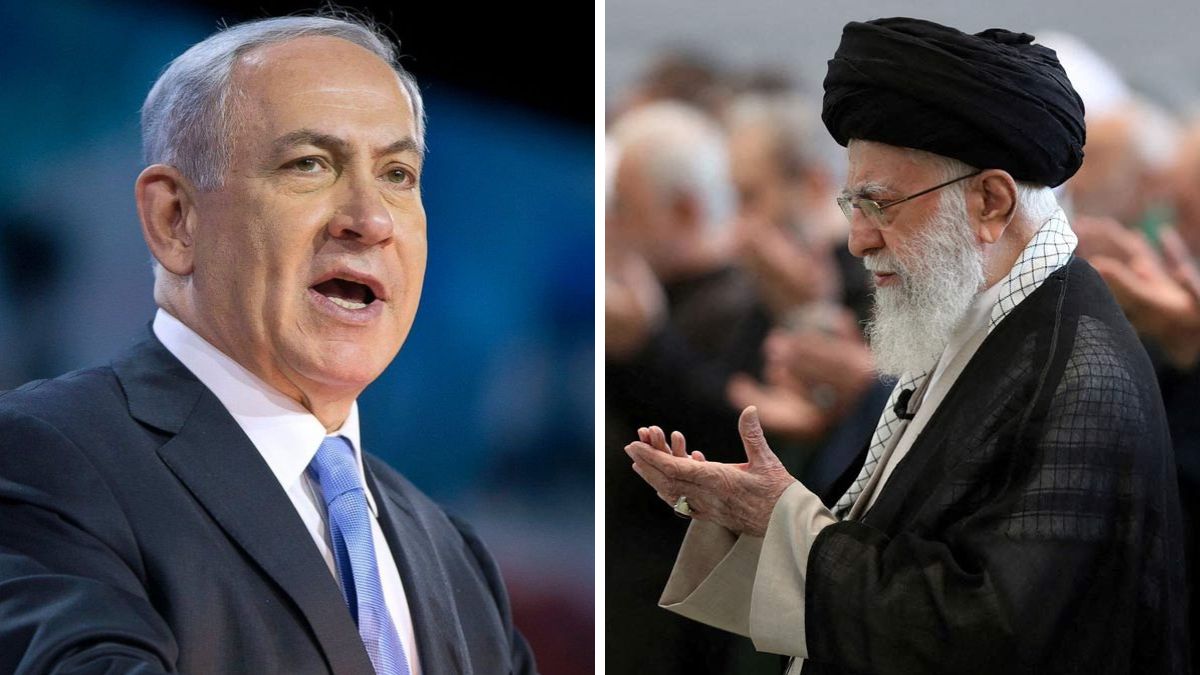Pre-emption and retaliation: The new phase of Israel-Iran war
 Israel Prime Minister Benjamin Netanyahu. (Right) Iran's Supreme Leader Ayathollah Khamenei | X
Israel Prime Minister Benjamin Netanyahu. (Right) Iran's Supreme Leader Ayathollah Khamenei | X
The Iran-Israel conflict has entered the fifth day on June 17, with both the sides escalating the attacks. Israeli military claims that it has killed Ali Shadmani who is also known as Iran’s wartime Chief of Staff. This comes after the Israeli attack on Iranian state-run television station on June 16.
This marks a profound transformation in what has long been described as a covert or “shadow war.” A shadow war is a type of covert conflict waged in the ambiguous space between war and peace, where various actors employ a range of clandestine methods to achieve their strategic objectives.
The events of mid-June 2025, particularly Israel’s sweeping airstrikes on Iranian soil under “Operation Rising Lion”, represent an unprecedented escalation. In a major escalation, the Israeli Air Force deployed over 200 aircraft to strike more than 100 strategic targets across Iran. These included critical nuclear facilities in Natanz, key missile sites and important command and control centres in the capital, Tehran, underscoring the scale and precision of Israel’s military operation. The attack was notably hybrid in nature, combining overt air raids with covert Mossad-led sabotage missions using drones to neutralise Iranian air defences. These strikes were not only militarily significant, taking out key Iranian Revolutionary Guard Corps (IRGC) figures and nuclear scientists, but also symbolically bold, as they pierced deep into Iranian territory in a pre-emptive effort to neutralise what Israel perceives as an existential nuclear threat.
In response, Iran launched a large-scale missile and drone barrage, reportedly involving over 150 ballistic missiles and more than 100 UAVs aimed at major Israeli cities such as Tel Aviv, Haifa, and Jerusalem. Although Israel’s Iron Dome and Arrow defence systems intercepted the majority of these, several penetrated, causing civilian casualties and infrastructural damage.
Casualty figures underscore the gravity of the confrontation, with the escalating numbers of both Iranian and Israeli citizens being reportedly killed, along with hundreds more injured on both sides. Among the Iranian dead were top-level military and nuclear personnel, a decapitation strategy that could weaken Iran's operational capacity in the short term. The damage extends beyond human losses—oil facilities, power plants, nuclear sites, ports, and key defence sites in both countries have been affected. The conflict has also triggered significant economic and geopolitical ripples. Oil prices surged by over 7 percent, global stock markets reacted with volatility, and countries across the region, including Pakistan and India, began assessing their strategic exposure, especially concerning energy supplies and expatriate populations.
Diplomatically, the crisis has reverberated through the G7 summit and the United Nations, with most global actors—including the EU, China, and the United States—calling for restraint. In the most recent development, US President Donald Trump has cut short his visit to the G7 summit in Canada in June 2025 due to escalating conflict between Iran and Israel. However, US officials have rejected suggestions that the US was about to join Israeli offensive operations against Iran.
Politically, this escalation has also drawn criticism of the Israeli leadership’s motivations. There have been speculative analysis in international media suggesting that Prime Minister Benjamin Netanyahu may be attempting to restore Israel’s tarnished international standing following the Gaza war by taking bold military action against Iran. The broader concern lies in the possibility that such unilateral military action erodes the international rules-based order and could provoke retaliatory actions not just from Iran, but from its regional proxies such as Hezbollah in Lebanon and the Houthis in Yemen. The possibility of a wider conflict involving these actors remains real, especially if Iranian infrastructure is continuously targeted or if Israeli cities suffer heavier casualties in future retaliatory waves.
While the scale and intensity of the strikes are historically unprecedented, the likelihood of a full-scale war between Israel and Iran remains uncertain but not improbable. Both countries have strong incentives to avoid a prolonged conventional war—Israel due to the economic and civilian toll, and Iran because of internal vulnerabilities exacerbated by leadership losses and public fear, as evident in the reported exodus from Tehran. Yet the dynamic of escalation remains fragile. If Iran rebuilds its capabilities and launches another large-scale retaliation, or if Israeli strikes continue in depth and frequency, the chances of a wider war involving regional proxies and potentially the US increase significantly. At present, the situation hangs in a dangerous balance, where miscalculation, political brinkmanship, or further provocations could easily push both nations beyond the threshold of limited conflict into full-fledged war.
The author is assistant professor, Amity Institute of Defence and Strategic Studies, Amity University, Noida.
Middle East